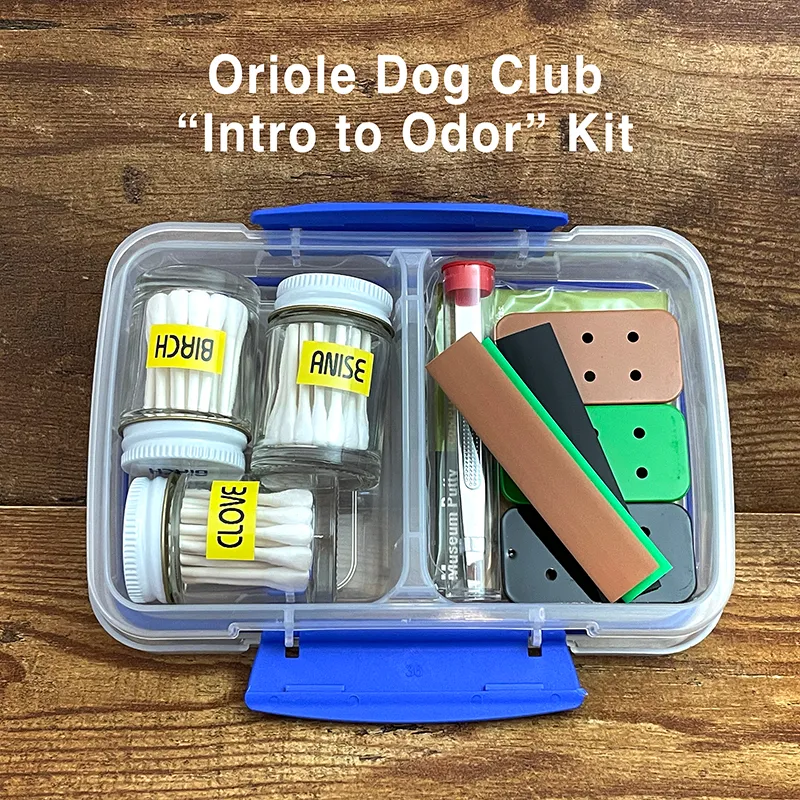These are a few of my favorite things…
These are all products I use or have used with my pups in nosework and life more generally. I recommend them because I do really like them. Some products may include an affiliate link, meaning I may receive compensation if you sign up or purchase an item.
Nosework Gear
All you really need is an 8-10 ft leash and a collar or harness for your dog. Some people like to use equipment that is exclusive to nosework, so the dog is clued in on which activity we’re doing. That can be helpful, but there are plenty of other ways to let the dog know that we’re doing nosework.
The most important thing is finding equipment that the dog finds comfortably and will even opt in to wearing. When selecting a harness, I look for a Y-shaped harness that allows full shoulder movement. It helps for the handler to have comfy things, too! I like the Duluth vest because it’s lightweight, has multiple pockets to stash toys, treats, hides, poop bags, etc., and can be easier to toss on than a treat pouch. Experiment to find what works for you!
Car & Crating Comfort
Our dogs will likely spend a lot of time hanging out in the car waiting for their turn. We want to make it an easy and relaxing process for them! Many dogs may be unsettled with car crating at first, but will relax when they realize going sniffing is on the other side. If your dog is panicky, very distressed, or panting and drooling a lot, please talk to your vet and a behavior professional about possible medications and protocols for addressing car sickness and anxiety.
If our vehicle has the space, the safest place for a dog to be in a car is in a crate. It keeps you from getting distracted while driving, keeps the dog protected in case of an accident, and keeps the dog from bolting in case of emergency. I use RuffLands for my dogs. If your car can’t accommodate a crate, you might research a harness and seat belt system. There are whole groups on Facebook dedicated to set ups for dog crates and containment in vehicles, so you can always research there. Speaking of safety, don’t forget human and canine first aid!
While the dogs are crated, I often give a frozen Toppl or Kong to help them pass the time. If I have to be away from the car, I feel better about something that they can lick and not choke on. A battery-powered fan helps keep the car cool, add ventilation, and offer a bit of white noise. The shade cloth makes your car look like a spaceship while also keeping it significantly cooler inside. It also provides another visual barrier for our more reactive dogs. A wireless thermometer offers peace of mind. A tailgate lock enables you to keep the tailgate open for ventilation without draining your battery or leaving the car unlocked. Just in case, it’s helpful to have a jumpstart kit.
Nosework Supplies
While our dogs are working on primary reinforcers of treats or toys, all we need are a variety of treats, boxes, and places to set hides. Dogs can learn just about everything they need to know while still working on primary, so there is no need to rush. There are many professional working dogs who spend a year on primary before training on target odors.
In K9NW , the target odors for competing in NACSWTM sanctioned trials are three essential oils:
Birch (specifically Sweet Birch) Betula lenta
Anise (specifically Aniseed) Pimpinella anisum (not to be confused with Star Anise – Illicium verum)
Clove (specifically Clove Bud) Syzygium aromaticum or Eugenia caryophyllata
Cotton swabs (Q-tips ®), cut in half, are scented with the oil using a specific method and placed inside various containers for hiding. It is important to use swabs of 100% cotton with paper stems, not plastic or wood. The containers that hold the cotton swabs are usually small tins, pieces of flex tubing, or hard plastic tubes.
Dogs are introduced to Birch first before adding Anise and Clove to their repertoire. While I am all for DIY, please do not introduce your dog to odor before we have covered it in class. This, again, ensures the team is set up for success.
You can scent your own Q-Tips or buy them pre-scented. Either way, the Q-Tips should be stored in an air-tight vessel to avoid contaminating other areas with odor. I keep my Q-Tips in a sealed glass jar, since glass is impermeable, and then keep my jars in an air-tight container. I also have a variety of tins, tubes, and smaller kits that are easy to travel with in an air-tight container, so we can practice in a lot of environments without having to load tins every time. Be careful with where and how you store your materials. *Once a surface has had odor on it, even if it unintentionally, we should consider it “hot.”
To get started, you might consider one of these kits. I also recommend getting some putty to hold your hides different places and some rare earth magnets if your tins didn’t come with any.























